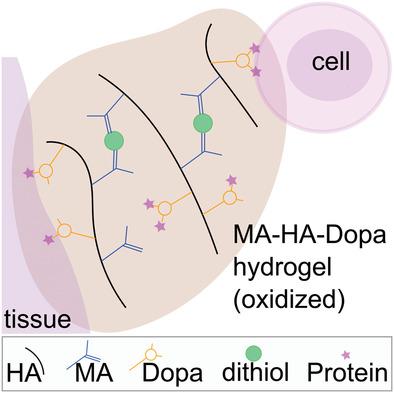当前位置:
X-MOL 学术
›
Adv. Healthcare Mater.
›
论文详情
Our official English website, www.x-mol.net, welcomes your feedback! (Note: you will need to create a separate account there.)
Adhesive Hydrogels for Maxillofacial Tissue Regeneration Using Minimally Invasive Procedures.
Advanced Healthcare Materials ( IF 10.0 ) Pub Date : 2020-01-14 , DOI: 10.1002/adhm.201901134 Christoph Salzlechner 1 , Tabasom Haghighi 1 , Isabella Huebscher 1 , Anders Runge Walther 1, 2 , Sophie Schell 1, 3 , Alexander Gardner 4 , Gerhard Undt 5 , Ricardo M P da Silva 1, 6 , Cécile A Dreiss 7 , Kathleen Fan 8 , Eileen Gentleman 1
Advanced Healthcare Materials ( IF 10.0 ) Pub Date : 2020-01-14 , DOI: 10.1002/adhm.201901134 Christoph Salzlechner 1 , Tabasom Haghighi 1 , Isabella Huebscher 1 , Anders Runge Walther 1, 2 , Sophie Schell 1, 3 , Alexander Gardner 4 , Gerhard Undt 5 , Ricardo M P da Silva 1, 6 , Cécile A Dreiss 7 , Kathleen Fan 8 , Eileen Gentleman 1
Affiliation

|
Minimally invasive surgical procedures aiming to repair damaged maxillofacial tissues are hampered by its small, complex structures and difficult surgical access. Indeed, while arthroscopic procedures that deliver regenerative materials and/or cells are common in articulating joints such as the knee, there are currently no treatments that surgically place cells, regenerative factors or materials into maxillofacial tissues to foster bone, cartilage or muscle repair. Here, hyaluronic acid (HA)-based hydrogels are developed, which are suitable for use in minimally invasive procedures, that can adhere to the surrounding tissue, and deliver cells and potentially drugs. By modifying HA with both methacrylate (MA) and 3,4-dihydroxyphenylalanine (Dopa) groups using a completely aqueous synthesis route, it is shown that MA-HA-Dopa hydrogels can be applied under aqueous conditions, gel quickly using a standard surgical light, and adhere to tissue. Moreover, upon oxidation of the Dopa, human marrow stromal cells attach to hydrogels and survive when encapsulated within them. These observations show that when incorporated into HA-based hydrogels, Dopa moieties can foster cell and tissue interactions, ensuring surgical placement and potentially enabling delivery/recruitment of regenerative cells. The findings suggest that MA-HA-Dopa hydrogels may find use in minimally invasive procedures to foster maxillofacial tissue repair.
中文翻译:

使用微创手术进行颌面组织再生的粘合水凝胶。
旨在修复受损颌面部组织的微创外科手术因其小而复杂的结构和难以手术进入而受到阻碍。事实上,虽然输送再生材料和/或细胞的关节镜手术在膝关节等关节中很常见,但目前还没有通过手术将细胞、再生因子或材料放入颌面部组织以促进骨骼、软骨或肌肉修复的治疗方法。这里开发了基于透明质酸(HA)的水凝胶,适用于微创手术,可以粘附到周围组织,并输送细胞和潜在的药物。通过使用完全水性合成路线用甲基丙烯酸酯(MA)和3,4-二羟基苯丙氨酸(Dopa)基团修饰HA,结果表明MA-HA-Dopa水凝胶可以在水性条件下应用,使用标准手术灯快速凝胶,并粘附在组织上。此外,多巴氧化后,人骨髓基质细胞会附着在水凝胶上,并在封装在水凝胶内时存活。这些观察结果表明,当掺入基于 HA 的水凝胶中时,多巴部分可以促进细胞和组织相互作用,确保手术放置并有可能实现再生细胞的输送/招募。研究结果表明,MA-HA-多巴水凝胶可用于微创手术,以促进颌面组织修复。
更新日期:2020-02-19
中文翻译:

使用微创手术进行颌面组织再生的粘合水凝胶。
旨在修复受损颌面部组织的微创外科手术因其小而复杂的结构和难以手术进入而受到阻碍。事实上,虽然输送再生材料和/或细胞的关节镜手术在膝关节等关节中很常见,但目前还没有通过手术将细胞、再生因子或材料放入颌面部组织以促进骨骼、软骨或肌肉修复的治疗方法。这里开发了基于透明质酸(HA)的水凝胶,适用于微创手术,可以粘附到周围组织,并输送细胞和潜在的药物。通过使用完全水性合成路线用甲基丙烯酸酯(MA)和3,4-二羟基苯丙氨酸(Dopa)基团修饰HA,结果表明MA-HA-Dopa水凝胶可以在水性条件下应用,使用标准手术灯快速凝胶,并粘附在组织上。此外,多巴氧化后,人骨髓基质细胞会附着在水凝胶上,并在封装在水凝胶内时存活。这些观察结果表明,当掺入基于 HA 的水凝胶中时,多巴部分可以促进细胞和组织相互作用,确保手术放置并有可能实现再生细胞的输送/招募。研究结果表明,MA-HA-多巴水凝胶可用于微创手术,以促进颌面组织修复。



























 京公网安备 11010802027423号
京公网安备 11010802027423号